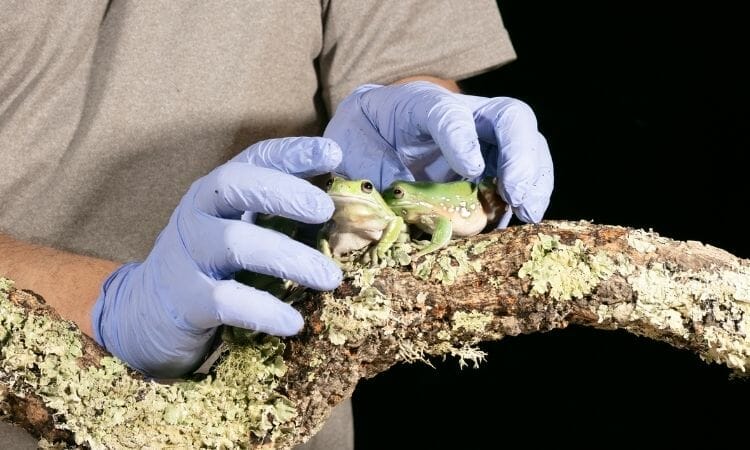Green tree frogs are fascinating animals from the amphibians family. They are popular as pets because of their tiny size, attractive look, and low-maintenance requirements. They are the most common tree frog native to the southeast U.S. from Florida to Virginia. Moreover, there is another variety available in Australia.
Most of the green tree frog species are Carnivorous (insectivores). They primarily consume small live insects like cricket, mosquitoes, moths, flies, and others in the wild. Now, take a look at their food list, eating habits, and what you can feed your pet green tree frogs.
What do Green Tree Frogs Eat?

Like other tree frogs, green frogs prefer to dine on small insects that they catch using their sticky tongues and quick reflexes.
Green tree frogs have a varied diet that depends on their age, gender, and environmental conditions. Baby frogs usually begin to eat soon after hatching. They do not have teeth, so they consume soft-bodied and small insects.
As they mature, these amphibians are able to hunt larger meals. Green tree frogs consume their food by grabbing it with their tongues and pulling it into their mouths without biting down.
Here is a list of food that they consume with pleasure.
- Crickets,
- Earthworms,
- Roaches,
- Grasshoppers,
- Moths,
- Maggots,
- Mosquitoes,
- Flies – Fruit flies, houseflies,
- Locusts,
- Spiders, etc.
What Should You Never Feed Them?
- Frogs are carnivores; avoid feeding your frog fruits or veggies.
- And never give your frog kitchen leftovers
- Commercial pet food meant for other animals in your household.
- If a live insect is too large
- Insects caught from the wild that may be contaminated with pesticides or parasites.
Wild Green Tree Frogs Food Habit

Green tree frogs are nocturnal. They eat primarily at night, although they may eat during the day if they are hungry enough. However, they are not fussy eaters and will travel up and down the trees to pursue any prey that would fit into their jaws.
They are passive feeders, like other frogs and lizards. They hunt and capture their prey with their sticky tongues rather than stalking and hunting. However, larger species may jump toward larger, faster-moving small animals.
Most tree frog species eat on insects, worms, larvae, and other tiny invertebrates in the wild. However, some more notable species may feed on spiders, lizards, snails, snakes, fish, and other frogs.
Feeding Your Pet Green Tree Frog

Green tree frogs are the most commonly kept species of tree frog. However, they can be somewhat challenging to care for if you don’t know what they eat and how much they should eat.
Here’s everything you need to know about the green tree frog diet, including what to feed them and how much food to give them at each feeding.
Due to their voracious appetites and fast reaction times, American green tree frogs make entertaining dining companions. They often react immediately, as soon as you put food into their cage.
As I have mentioned earlier, they eat live insects. Therefore, their diet is mainly filled with nutrient-rich live proteins. And tree frogs will most likely consume more food in the spring and summer than in the winter.
Water is one of the most essential for any living creatures. You have to provide an extensive, shallow, durable water bowl filled with dechlorinated water. However, they are not a good swimmer, so make sure the water bowl is not too deep for them.
Now let’s learn what you can provide to your pet green frog.
- Four to Five gut-loaded crickets each day will keep your tree frog happy.
- Feed tiny frogs daily, whereas larger frogs can be fed daily or every other day.
- They love black cricket over brown ones.
- Be sure to purchase your crickets from a reputable dealer who raised them humanely and fed a balanced diet.
- You may add different bugs such as mealworms, grasshoppers, or roaches into their diet.
- Wild insects may contain diseases.
- Before providing water to your frog, spray the tank to give hydration and maintain a high humidity level.
- Overfeeding is one of the most common causes of illness among captive frogs.
- To ensure proper nutrition, give them only what they can consume within five minutes—remove any leftovers.
- Before feeding them, properly wash your hands or use gloves. Frogs’ skin is fragile, and the chemicals and oils on your hands can be toxic to them.
Is It Necessary for My Frog to Take Vitamins or Supplements?
The frog food you select must have an adequate amount of Vitamin A. Unfortunately, the frog’s body cannot generate on its own. Besides, they may lack calcium and minerals too.
Final Words
Green tree frogs may easily survive up to 8 years with proper care, and food and are usually simple to house and care for. The majority of tree frog species will live on an insect diet, particularly gut-loaded crickets.


You May Also Read